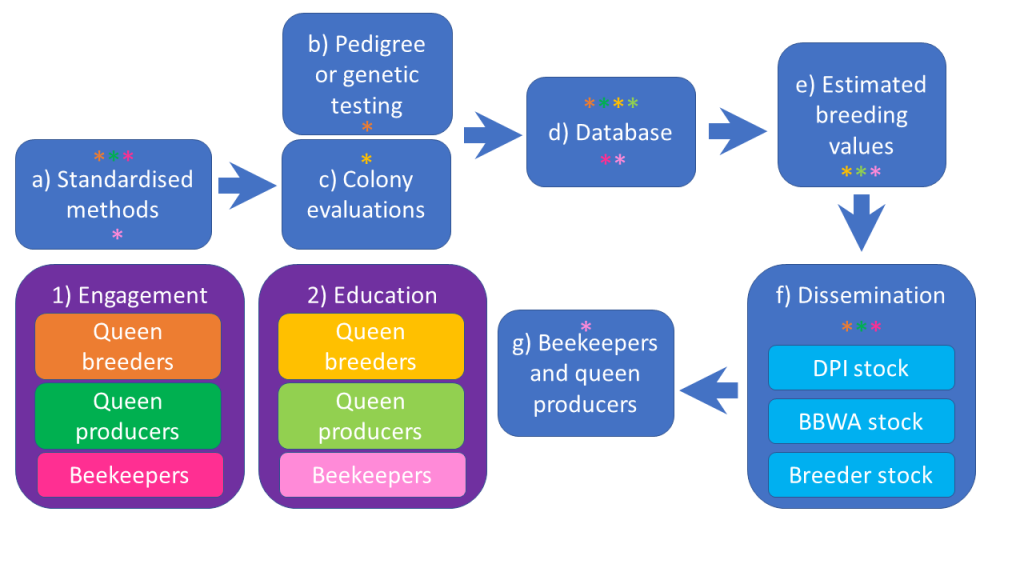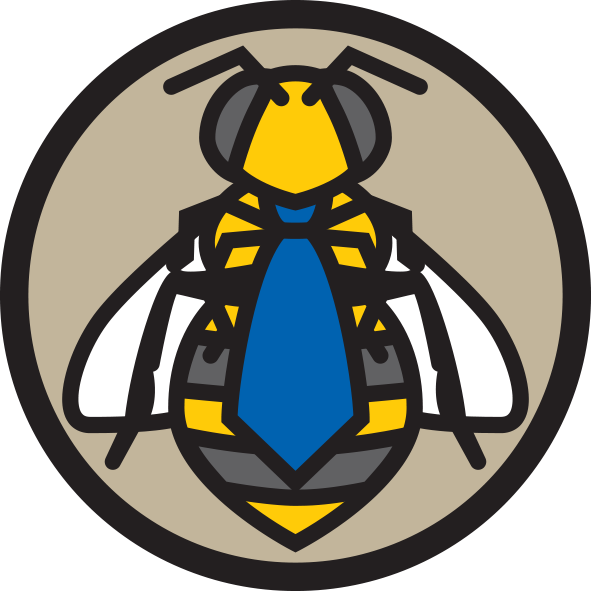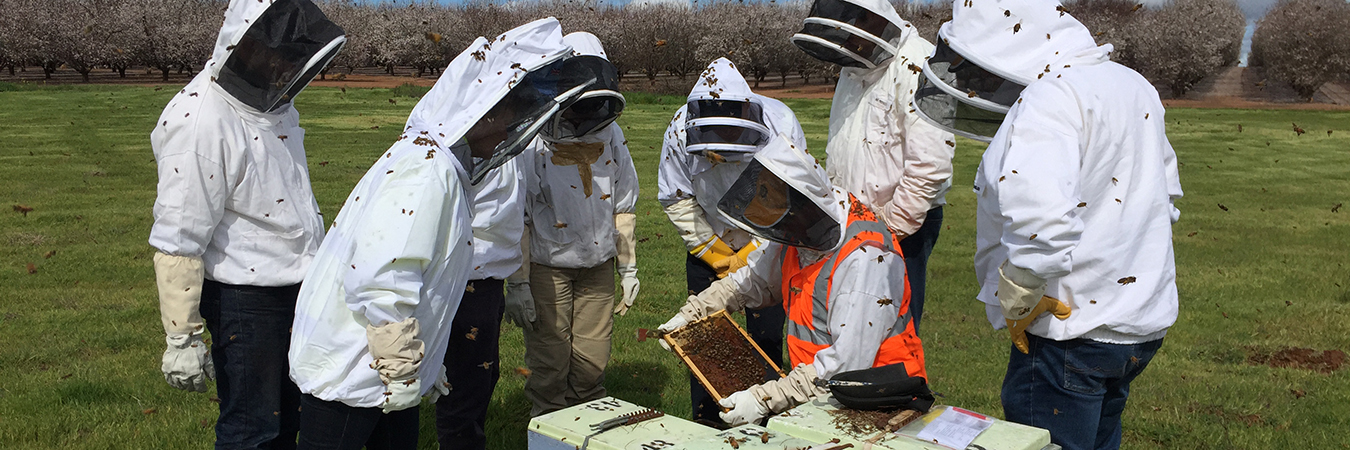Plan Bee aims to work with queen breeders, producers, beekeepers and growers to create a sustainable national honey bee genetic improvement program using innovative breeding technologies to transform the performance of honey bees in Australia. It will focus simultaneously on traits of importance to beekeepers, and of the horticulture and broadacre industries dependent on honey bee pollination. The strength of this project lies in its ability to deliver benefits across multiple industries by creating a more profitable and sustainable beekeeping industry, improving crop pollination efficiency, and enabling industry expansion through enhanced pollination security.
Video: Nadine Chapman from the University of Sydney talks about the National Honey Bee Genetic Improvement Program
Goals
Queen breeders
- Breeding is valued and rewarded appropriately
- Increased demand for queens
- New entrants to the industry due to increased demand
- Facilities to improve stock at a faster rate
- An established breeding program that can be adapted to selection for Varroa resistance if/when the pest becomes established
Queen producers
- Increased demand for queens
- New entrants to the industry due to increased demand
- Mechanisms to choose improved stock suitable for their conditions
- An established breeding program that can be adapted to selection for Varroa resistance if/when the pest becomes established
Beekeepers
- Improved communication of what traits are selected for and how
- Increased resilience due to selection for disease resistance
- Increased profitability from selecting stock for production and disease resistance
- Mechanisms to choose improved stock suitable for their conditions
- A means to choose a queen breeder/producer with good genetics for traits of importance to them
- An established breeding program that can be adapted to selection for Varroa resistance if/when the pest becomes established
Growers
- Strong beekeeping industry due to improvements in profitability
- Strong colonies for pollination due to selection for disease resistance
- Colonies whose temperament is preferred for pollination i.e. lower risk of aggression
- Improved knowledge of colony management for pollination, and if that differs for different crops e.g. crops that need pollen versus nectar foragers
- An established breeding program that can be adapted to selection for Varroa resistance if/when the pest becomes established

a) Standardised methods
Having standardised methods provides certainty that queens were selected in an effective way for traits of interest. Queen breeders will differ in the traits that they select for. In addition, they may use one of several methods for assessing a given trait. As a simple example, some breeders will select for honey production by rating colonies on a scale from 1 (poor) to 5 (excellent), while other breeders will weigh how much honey is produced by each individual colony. As the point is for individual breeders to choose the best colonies from amongst their stock to produce the next generation, it is not necessary that every breeder uses exactly the same method, as long as they follow a sound procedure and apply it consistently to their stock.
The R&D apiary at Tocal, NSW DPI, will provide an opportunity to evaluate different methods of assessing traits – for instance comparing scoring honey production on a 1-5 scale, compared with weighing hives. Such comparisons will help breeders identify the most cost-effective methods to use in their own programs.
Beekeepers, queen breeders, and queen producers have been engaged to determine the traits that are important to them.
Queen breeders (and possibly producers) will play a vital role in developing a standardised trait selection manual – which will help us determine which trait assessment methods are most useful.
Queen breeders will also play a vital role in consideration of the most appropriate goals for breeding programs – what traits are important, how important are they, is there likely to be one type of bee that suits all environments and roles, or a range?
The most important message here is that the project will be open to participation and involvement from all who wish to be involved.
b) Pedigree or genetic testing
Estimated breeding values (EBVs) use known relationships between individuals and the individuals’ performance to determine their genetic merit. Therefore, participation in Plan Bee will require the provision of pedigrees or samples for genetic testing. The use of genetic testing improves accuracy because it is possible to determine which queens are half-sisters or super-sisters, through either their mother or their father.
We will work with queen breeders to develop a fair access model for genetic testing. Stock from NSW DPI and Better Bees WA (BBWA) will have priority. Further testing will depend on available funding as the program expands.
c) Colony evaluations
Colony evaluations can be recorded manually, or using an App developed by BBWA.
Queen breeders will be trained in how to use the App. We will also hold workshops for those with further questions about how to use the standardised manual. Tocal College Registered Training Organisation will include the standardised manual in their Queen Breeding Course.
d) Database
The database will house information on the relationships between queens, either through entry of pedigree or through genetic testing, along with colony performance data. Data from colony evaluations will either be entered manually or via the App.
Queen breeders and producers will be involved in the setup of the database. We must consider questions such as:
- Privacy
- Security
- Customised information access
- Pending breeders’ permission, determine what data is appropriate to compare
Training for queen breeders in the use of the database will be an early priority. As the project progresses, and once decisions have been made about database access, this training will be extended to beekeepers and queen producers.
e) Estimated breeding values
EBVs will be generated using the data entered into the database. These will then be provided to the queen breeder for them to make the final decision about which colonies they will select to produce the next generation. Training will be provided to assist this process.
f) Dissemination
Beekeepers have been engaged to determine the information they would like to have when making decisions about queen purchase. We will further engage with queen breeders and producers to develop our dissemination strategy, which will be specific to the stock.
Queen breeders will continue to sell their stock as usual. There will be the means to acknowledge the work that they have put into their breeding: what traits and how they were selected for, should they choose.
BBWA will develop a plan to distribute their stock.
Plan Bee will work with industry to develop a fair system for getting our stock (NSW DPI) out to industry.
g) Beekeepers/queen buyers
In order to grow the queen bee market, the program will provide training for beekeepers on:
- The importance of breeding and having quality queens
- The role of genetic testing
- How EBVs work
- Importance of environmental effects and choosing the right queen for you
Activities not included in the diagram
- Literature review of past and current bee breeding programs, including breeding structures
- Examination of management and other traits that will improve the value of colonies for pollination
- A genetic study of Australia’s breeding population
- Domestic queen bee market analysis
- Economic modelling and a business case
- Development of seasonal hive management strategies and floral resource tracking
- Survey of the needs of growers
Acknowledgements:
- Plan Bee (National Honey Bee Genetic Improvement Program) is supported by funding from the Australian Government Department of Agriculture, Water and the Environment as part of its Rural Research and Development for Profit program. The project is further supported by AgriFutures Australia, the Department of Regional NSW (formerly NSW DPI), University of Sydney, Animal Genetics and Breeding Unit, Better Bees WA Inc, Wheen Bee Foundation, CostaGroup, Olam, Beechworth Honey, Monson’s Honey and Pollination, Auston, South Pacific Seeds, and commercial beekeepers.
- This article was peer-reviewed by Elizabeth Frost and Robert Banks.



One comment, add yours.
Mick Rankmore
All very exciting.